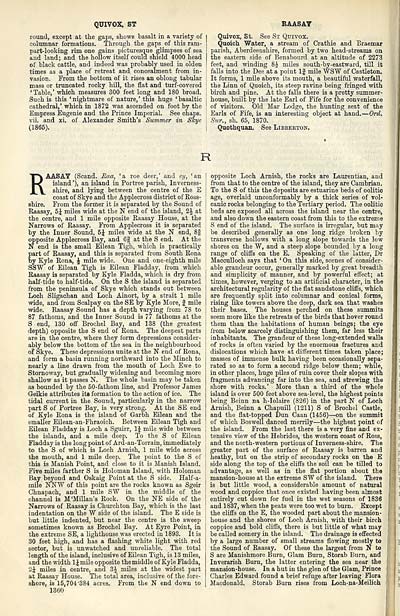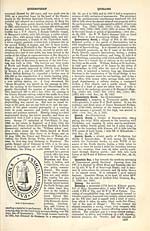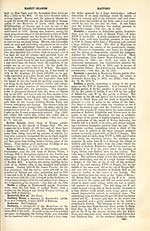Ordnance gazetteer of Scotland
(1368) Page 1360
Download files
Complete book:
Individual page:
Thumbnail gallery: Grid view | List view

QUIVOX, ST
round, except at the gaps, shows basalt in a variety of
columnar formations. Through the gaps of this ram-
part-looking rim one gains picturesque glimpses of sea
and land; and the hollow itself could shield 4000 head
of black cattle, and indeed was probably used in olden
times as a place of retreat and concealment from in-
vasion. From the bottom of it rises an oblong tabular
mass or truncated rocky hill, the flat and turf-covered
'Table,' which measures 300 feet long and 180 broad.
Such is this ' nightmare of nature, ' this huge ' basaltic
cathedral,' which in 1872 was ascended on foot by the
Empress Eugenie and the Prince Imperial. See chaps.
vii. and xi. of Alexander Smith's Summer in Skye
(1865).
RAASAY
Quivox, St. See St Qtjivox.
Quoich Water, a stream of Crathie and Eraemar
parish, Aberdeenshire, formed by two head-streams on
the eastern side of Benabourd at an altitude of 2273
feet, and winding 8J miles south-by-eastward, till it
falls into the Dee at a point If mile WSW of Castleton.
It forms, 1 mile above its mouth, a beautiful waterfall,
the Linn of Quoich, its steep ravine being fringed with
birch and pine. At the falls there is a pretty summer-
house, built by the late Earl of Fife for the convenience
of visitors. Old Mar Lodge, the hunting seat of the
Earls of Fife, is an interesting object at hand. — Ord.
Sur., sh. 65, 1870.
Quothquan. See Libberton.
R
RAASAT (Scand. Maa, 'a roe deer,' and ey, 'an
island '), an island in Portree parish, Inverness-
shire, and lying between the centre of the E
coast of Skye and the Applecross district of Ross-
shire. From the former it is separated by the Sound of
Raasay, 5J miles wide at the N end of the island, 2£ at
the centre, and 1 mile opposite Raasay House, at the
Narrows of Raasay. From Applecross it is separated
by the Inner Sound, 5J miles wide at the N end, 8|
opposite Applecross Bay, and 6| at the S end. At the
N end is the small Eilean Tigh, which is practically
part of Raasay, and this is separated from South Rona
by Kyle Rona, J mile wide. One and one-eighth mile
SSW of Eilean Tigh is Eilean Fladday, from which
Raasay is separated by Kyle Fladda, which is dry from
half-tide to half-tide. On the S the island is separated
from the peninsula of Skye which stands out between
Loch Sligachan and Loch Ainort, by a strait 1 mile
wide, and from Scalpay on the SE by Kyle More, -f mile
wide. Raasay Sound has a depth varying from 78 to
87 fathoms, and the Inner Sound is 77 fathoms at the
S end, 130 off Brochel Bay, and 138 (the greatest
depth) opposite the S end of Rona. The deepest parts
are in the centre, where they form depressions consider-
ably below the bottom of the sea in the neighbourhood
of Skye. These depressions unite at the N end of Rona,
and form a basin running northward into the Minch to
nearly a line drawn from the mouth of Loch Ewe to
Stornoway, but gradually widening and becoming more
shallow as it passes N. The whole basin may be taken
as bounded by the 50-fathom line, and Professor James
Geikie attributes ita formation to the action of ice. The
tidal current in the Sound, particularly in the narrow
part S of Portree Bay, is very strong. At the SE end
of Kyle Rona is the island of Garbh Eilean and the
smaller Eilean-an-Fhraoieh. Between Eilean Tigh and
Eilean Fladday is Loch a Sguirr, 1J mile wide between
the islands, and a mile deep. To the S of Eilean
Fladday is the long point of Ard-an-Torrain, immediately
to the S of which is Loch Arnish, 1 mile wide across
the mouth, and 1 mile deep. The point to the S of
this is Manish Point, and close to it is Manish Island.
Five miles farther S is Holoman Island, with Holoman
Bay beyond and Oskaig Point at the S side. Half-a-
mile NNW of this point are the rocks known as Sgeir
Ghnapach, and 1 mile SW in the middle of the
channel is M'Millan's Rock. On the NE side of the
Narrows of Raasay is Churchton Bay, which is the last
indentation on the W side of the island. The E side is
but little indented, but near the centre is the sweep
sometimes known as Brochel Bay. At Eyre Point, in
the extreme SE, a lighthouse was erected in 1893. It is
30 feet high, and has a flashing white light with red
sector, but is unwatched and unreliable. The total
length of the island, inclusive of Eilean Tigh, is 13 miles,
and the width ljmile opposite the middle of Kyle Fladda,
2J miles in centre, and 3J miles at the widest part
at Raasay House. The total area, inclusive of the fore-
shore, is 15, 704 "384 acres. From the N end down to
1360
opposite Loch Arnish, the rocks are Laurentian, and
from that to the centre of the island, they are Cambrian.
To the S of this the deposits are estuarine beds of oolitic
age, overlaid unconformably by a thick series of vol-
canic rocks belonging to the Tertiary period. The oolitic
beds are exposed all across the island near the centre,
and also down the eastern coast from this to the extreme
S end of the island. The surface is irregular, but may
be described generally as one long ridge broken by
transverse hollows with a long slope towards the low
shores on the W, and a steep slope bounded by a long
range of cliffs on the E. Speaking of the latter, Dr
Macculloch says that ' On this side, scenes of consider-
able grandeur occur, generally marked by great breadth
and simplicity of manner, and by powerful effect; at
times, however, verging to an artificial character, in the
architectural regularity of the flat sandstone cliffs, which
are frequently split into columnar and conical forms,
rising like towers above the deep, dark sea that washes
their bases. The houses perched on these summits
seem more like the retreats of the birds that hover round
them than the habitations of human beings; the eye
from below scarcely distinguishing them, far less their
inhabitants. The grandeur of these long-extended walls
of rocks is often varied by the enormous fractures and
dislocations which have at different times taken place;
masses of immense bulk having been occasionally sepa-
rated so as to form a second ridge below them; while,
in other places, huge piles of ruin cover their slopes with
fragments advancing far into the sea, and strewing the
shore with rocks.' More than a third of the whole
island is over 500 feet above sea-level, the highest points
being Beinn na h-Iolaire (826) in the part N of Loch
Arnish, Beinn a Chapuill (1211) S of Brochel Castle,
and the flat-topped Dun Caan (1456) — on the summit
of which Boswell danced merrily — the highest point of
the island. From the last there is a very fine and ex-
tensive view of the Hebrides, the western coast of Ross,
and the north-western portions of Inverness-shire. The
greater part of the surface of Raasay is barren and
heathy, but on the strip of secondary rocks on the E
side along the top of the cliffs the soil can be tilled to
advantage, as well as in the flat portion about the
mansion-house at the extreme SW of the island. There
is but little wood, a considerable amount of natural
wood and coppice that once existed having been almost
entirely cut down for fuel in the wet seasons of 1836
and 1837, when the peats were too wet to burn. Except
the cliffs on the E, the wooded part about the mansion-
house and the shores of Loch Arnish, with their birch
coppice and bold cliffs, there is but little of what may
be called scenery in the island. The drainage is effected
by a large number of small streams flowing mostly to
the Sound of Raasay. Of these the largest from N to
S are Manishmore Burn, Glam Burn, Storab Burn, and
Inverarish Burn, the latter entering the sea near the
mansion-house. In a hut in the glen of the Glam, Prince
Charles Edward found a brief refuge after leaving Flora
Macdonald. Storab Burn rises from Loch-na-Meilicb.
round, except at the gaps, shows basalt in a variety of
columnar formations. Through the gaps of this ram-
part-looking rim one gains picturesque glimpses of sea
and land; and the hollow itself could shield 4000 head
of black cattle, and indeed was probably used in olden
times as a place of retreat and concealment from in-
vasion. From the bottom of it rises an oblong tabular
mass or truncated rocky hill, the flat and turf-covered
'Table,' which measures 300 feet long and 180 broad.
Such is this ' nightmare of nature, ' this huge ' basaltic
cathedral,' which in 1872 was ascended on foot by the
Empress Eugenie and the Prince Imperial. See chaps.
vii. and xi. of Alexander Smith's Summer in Skye
(1865).
RAASAY
Quivox, St. See St Qtjivox.
Quoich Water, a stream of Crathie and Eraemar
parish, Aberdeenshire, formed by two head-streams on
the eastern side of Benabourd at an altitude of 2273
feet, and winding 8J miles south-by-eastward, till it
falls into the Dee at a point If mile WSW of Castleton.
It forms, 1 mile above its mouth, a beautiful waterfall,
the Linn of Quoich, its steep ravine being fringed with
birch and pine. At the falls there is a pretty summer-
house, built by the late Earl of Fife for the convenience
of visitors. Old Mar Lodge, the hunting seat of the
Earls of Fife, is an interesting object at hand. — Ord.
Sur., sh. 65, 1870.
Quothquan. See Libberton.
R
RAASAT (Scand. Maa, 'a roe deer,' and ey, 'an
island '), an island in Portree parish, Inverness-
shire, and lying between the centre of the E
coast of Skye and the Applecross district of Ross-
shire. From the former it is separated by the Sound of
Raasay, 5J miles wide at the N end of the island, 2£ at
the centre, and 1 mile opposite Raasay House, at the
Narrows of Raasay. From Applecross it is separated
by the Inner Sound, 5J miles wide at the N end, 8|
opposite Applecross Bay, and 6| at the S end. At the
N end is the small Eilean Tigh, which is practically
part of Raasay, and this is separated from South Rona
by Kyle Rona, J mile wide. One and one-eighth mile
SSW of Eilean Tigh is Eilean Fladday, from which
Raasay is separated by Kyle Fladda, which is dry from
half-tide to half-tide. On the S the island is separated
from the peninsula of Skye which stands out between
Loch Sligachan and Loch Ainort, by a strait 1 mile
wide, and from Scalpay on the SE by Kyle More, -f mile
wide. Raasay Sound has a depth varying from 78 to
87 fathoms, and the Inner Sound is 77 fathoms at the
S end, 130 off Brochel Bay, and 138 (the greatest
depth) opposite the S end of Rona. The deepest parts
are in the centre, where they form depressions consider-
ably below the bottom of the sea in the neighbourhood
of Skye. These depressions unite at the N end of Rona,
and form a basin running northward into the Minch to
nearly a line drawn from the mouth of Loch Ewe to
Stornoway, but gradually widening and becoming more
shallow as it passes N. The whole basin may be taken
as bounded by the 50-fathom line, and Professor James
Geikie attributes ita formation to the action of ice. The
tidal current in the Sound, particularly in the narrow
part S of Portree Bay, is very strong. At the SE end
of Kyle Rona is the island of Garbh Eilean and the
smaller Eilean-an-Fhraoieh. Between Eilean Tigh and
Eilean Fladday is Loch a Sguirr, 1J mile wide between
the islands, and a mile deep. To the S of Eilean
Fladday is the long point of Ard-an-Torrain, immediately
to the S of which is Loch Arnish, 1 mile wide across
the mouth, and 1 mile deep. The point to the S of
this is Manish Point, and close to it is Manish Island.
Five miles farther S is Holoman Island, with Holoman
Bay beyond and Oskaig Point at the S side. Half-a-
mile NNW of this point are the rocks known as Sgeir
Ghnapach, and 1 mile SW in the middle of the
channel is M'Millan's Rock. On the NE side of the
Narrows of Raasay is Churchton Bay, which is the last
indentation on the W side of the island. The E side is
but little indented, but near the centre is the sweep
sometimes known as Brochel Bay. At Eyre Point, in
the extreme SE, a lighthouse was erected in 1893. It is
30 feet high, and has a flashing white light with red
sector, but is unwatched and unreliable. The total
length of the island, inclusive of Eilean Tigh, is 13 miles,
and the width ljmile opposite the middle of Kyle Fladda,
2J miles in centre, and 3J miles at the widest part
at Raasay House. The total area, inclusive of the fore-
shore, is 15, 704 "384 acres. From the N end down to
1360
opposite Loch Arnish, the rocks are Laurentian, and
from that to the centre of the island, they are Cambrian.
To the S of this the deposits are estuarine beds of oolitic
age, overlaid unconformably by a thick series of vol-
canic rocks belonging to the Tertiary period. The oolitic
beds are exposed all across the island near the centre,
and also down the eastern coast from this to the extreme
S end of the island. The surface is irregular, but may
be described generally as one long ridge broken by
transverse hollows with a long slope towards the low
shores on the W, and a steep slope bounded by a long
range of cliffs on the E. Speaking of the latter, Dr
Macculloch says that ' On this side, scenes of consider-
able grandeur occur, generally marked by great breadth
and simplicity of manner, and by powerful effect; at
times, however, verging to an artificial character, in the
architectural regularity of the flat sandstone cliffs, which
are frequently split into columnar and conical forms,
rising like towers above the deep, dark sea that washes
their bases. The houses perched on these summits
seem more like the retreats of the birds that hover round
them than the habitations of human beings; the eye
from below scarcely distinguishing them, far less their
inhabitants. The grandeur of these long-extended walls
of rocks is often varied by the enormous fractures and
dislocations which have at different times taken place;
masses of immense bulk having been occasionally sepa-
rated so as to form a second ridge below them; while,
in other places, huge piles of ruin cover their slopes with
fragments advancing far into the sea, and strewing the
shore with rocks.' More than a third of the whole
island is over 500 feet above sea-level, the highest points
being Beinn na h-Iolaire (826) in the part N of Loch
Arnish, Beinn a Chapuill (1211) S of Brochel Castle,
and the flat-topped Dun Caan (1456) — on the summit
of which Boswell danced merrily — the highest point of
the island. From the last there is a very fine and ex-
tensive view of the Hebrides, the western coast of Ross,
and the north-western portions of Inverness-shire. The
greater part of the surface of Raasay is barren and
heathy, but on the strip of secondary rocks on the E
side along the top of the cliffs the soil can be tilled to
advantage, as well as in the flat portion about the
mansion-house at the extreme SW of the island. There
is but little wood, a considerable amount of natural
wood and coppice that once existed having been almost
entirely cut down for fuel in the wet seasons of 1836
and 1837, when the peats were too wet to burn. Except
the cliffs on the E, the wooded part about the mansion-
house and the shores of Loch Arnish, with their birch
coppice and bold cliffs, there is but little of what may
be called scenery in the island. The drainage is effected
by a large number of small streams flowing mostly to
the Sound of Raasay. Of these the largest from N to
S are Manishmore Burn, Glam Burn, Storab Burn, and
Inverarish Burn, the latter entering the sea near the
mansion-house. In a hut in the glen of the Glam, Prince
Charles Edward found a brief refuge after leaving Flora
Macdonald. Storab Burn rises from Loch-na-Meilicb.
Set display mode to: Large image | Transcription
Images and transcriptions on this page, including medium image downloads, may be used under the Creative Commons Attribution 4.0 International Licence unless otherwise stated. ![]()
| Gazetteers of Scotland, 1803-1901 > Ordnance gazetteer of Scotland > (1368) Page 1360 |
|---|
| Permanent URL | https://digital.nls.uk/97409662 |
|---|

